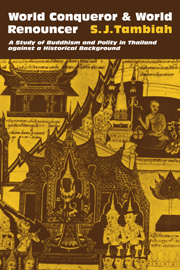 World Conqueror and World Renouncer
World Conqueror and World Renouncer Published online by Cambridge University Press: 10 November 2010
It is a commonplace of scholarship that the Buddha himself is credited with the recommendation that the community of bhikkhus organize and conduct their affairs in a fashion that is the very antithesis of the procedures of a centralized polity. In the Maha Parinibbana Suttanta the Buddha recommends that the bhikkhus conduct their affairs in the Vajjian style (which certain scholars label as the “republican” model as opposed to the “monarchical”): “So long, O mendicants, as the brethren foregather oft, and frequent the formal meetings of their Order – so long as they meet in concord, and rise in concord, and carry out in concord the duties of the Order. … so long may the brethren be expected not to decline, but to prosper.”
Further along in this famous discourse occurs the much quoted admonition to Ananda that the continuance of the brotherhood does not depend upon a leader: “Therefore, O Ananda, be ye lamps unto yourselves. Be ye a refuge to yourselves. … Look not for refuge to any one besides yourselves. …”
We have already (Chapter 5) cautioned against a simplistic assimilation of the Vajjian political style to a republican model, although the Buddha's alleged advice on how the sangha should conduct its affairs is a meaningful contrast with the conventions of kingly rule.
To save this book to your Kindle, first ensure [email protected] is added to your Approved Personal Document E-mail List under your Personal Document Settings on the Manage Your Content and Devices page of your Amazon account. Then enter the ‘name’ part of your Kindle email address below. Find out more about saving to your Kindle.
Note you can select to save to either the @free.kindle.com or @kindle.com variations. ‘@free.kindle.com’ emails are free but can only be saved to your device when it is connected to wi-fi. ‘@kindle.com’ emails can be delivered even when you are not connected to wi-fi, but note that service fees apply.
Find out more about the Kindle Personal Document Service.
To save content items to your account, please confirm that you agree to abide by our usage policies. If this is the first time you use this feature, you will be asked to authorise Cambridge Core to connect with your account. Find out more about saving content to Dropbox.
To save content items to your account, please confirm that you agree to abide by our usage policies. If this is the first time you use this feature, you will be asked to authorise Cambridge Core to connect with your account. Find out more about saving content to Google Drive.